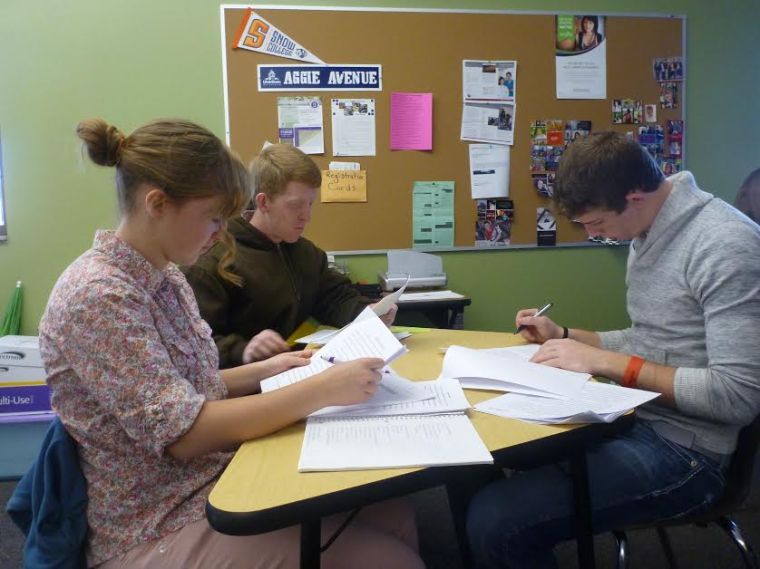More students at Grand County High School are succeeding with a newly streamlined concurrent enrollment program with Utah State University-Moab. Working together, the two educational institutions have improved a program that allows juniors and seniors to complete up to 20 credit hours of college general education classes at almost no cost.
The Utah System of Higher Education first adopted a rule regarding concurrent enrollment in the late 1980s. The popularity of the program took off in the late nineties and participation has continued to grow across the state. However, in Grand County, it is in the past year that the number of participants has jumped from ten to 15 students per trimester to over 50 in the first trimester of the current school year.
“Concurrent enrollment has evolved over the years. It’s really been over the past couple of years that we’ve tried to take it into a new direction that would be more basic and more useful, and I think that’s starting to happen,” said Steve Hawks, associate dean and executive director of USU-Moab.
Hawks said the biggest problem the program faced was in offering too many different classes without enough academic advising to guide students. As a result, many students were taking classes for credits they did not need.
As a solution, USU narrowed the options to only key classes that fill specific general education requirements. Also, they strengthened their advising component, a role fulfilled by Sam Sturman, associate director of USU-Moab.
“A lot of times, students know what they want to do but don’t really know exactly what it takes to do that or what the costs will be,” Sturman said.
To help students navigate the complexities, Sturman works to understand their educational and career goals and then give them realistic expectations of the path they need to take and the cost of getting through college and into a career.
“We’ve got everything streamlined, but the other part of the equation as far as success has been the overwhelming support of the high school,” Hawks said.
A little over a year ago, Hawks and Sturman began meeting with Dr. Scott Crane, Grand County School District’s superintendent, who was immediately enthusiastic about the program.
“I appreciate the cooperation between USU and the high school because this is an important emphasis for the district to have,” Crane said. “If you can give a child the opportunity to experience a college level class they will be more apt to go to college—any type of college or any type of post-high school training, and they will be more successful, I believe, in that post-high school training.”
Dr. Crane pulled together a working group that included GCHS principal Dr. Steve Hren, GCHS counselor Tom Edward and the concurrent enrollment facilitator Tamara Larsen.
The group helps facilitate the program at the high school and keeps the students on track for success.
“Mrs. Larsen does an outstanding job. She works with the students and advocates for them when necessary and will hold them accountable when needed. Mr. Edwards, our counselor, advises students about the concurrent enrollment and we all attend meetings with USU folks so we are all on the same page. This has worked well,” Hren said.
“I think the program is much more understandable now than it used to be and students and parents are able to see that this is a good value and a great way to start the college process.” said Hawks, whose son Justin is a high school senior now enrolled in the program.
The classes are taught by USU faculty. Students are expected to perform at a college level. The USU website advises that for every hour of college coursework, a student is expected to do an additional two hours of studies.
“They’re true college level classes. It’s going to be intensive and once students enroll and start taking a class they will be generating a college transcript and will have a grade that will bless them or harm them throughout their college career,” Hawks said.
Because of the rigor, juniors are not eligible unless they have a 3.5 GPA; seniors need a 3.0 to qualify.
If they qualify, students can complete a true freshman year of college by the time they graduate from high school. Because the general education requirements are the same throughout Utah, these credits can transfer directly to any Utah higher education institution.
“What this does is give students the opportunity to get college experience at a very reduced cost,” Crane said.
Students have to pay an initial USU application fee of $50, but thereafter it is $5 per credit hour. That means that a three-credit course costs $15 dollars, hundreds less than it would at full tuition prices. Then, there’s the cost of books and living expenses.
“Through the concurrent enrollment program, students can shave off a year of school and save somewhere between $15,000 and $18,000,” said Sturman.
The value isn’t just about the future.
Senior Tiffanie Whipple, who will have 21 credits completed by the time she graduates, also appreciates the program for giving her senior year more substance.
“You have to have a full schedule if you want to play a sport. So sometimes you have a class like office-aide—a bunch of ‘you-don’t-learn-anything’ classes. They’re just there to take up time,” Whipple said.
Junior Beilee Pilibosian has participated in three concurrent enrollment classes so far this year.
“I absolutely love them. They are very involved and require actual thought,” she said. “My favorite part is that you get the real idea of what college is going to be like and the kind of commitment you are going to be making if you are going to college after high school.”
Concurrent enrollment through USU-Moab allows students to complete first year of college while in high school
“A lot of times, students know what they want to do but don’t really know exactly what it takes to do that or what the costs will be.”




